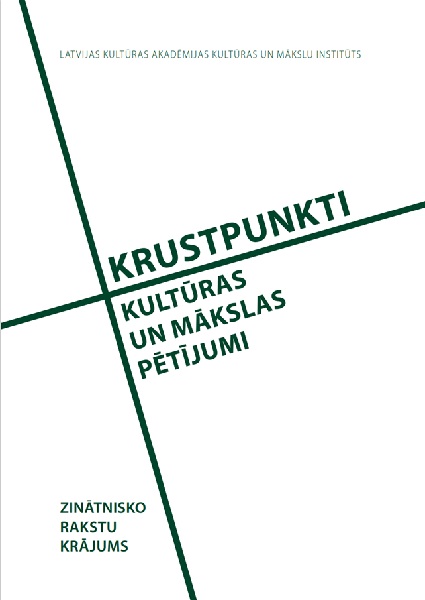SOVIET LOVE IN 1970s RIGA FILM STUDIO FILMS COMMISSIONED BY CENTRAL TELEVISION
DOI:
https://doi.org/10.55877/kkmp.2024.2.507Keywords:
the 20th century films, narrative, Riga Film Studio, Central Television of the USSR (CT), Soviet loveAbstract
In the 1970s, Riga Film Studio (RFS) produced 18 television films, commissioned by the Central Television of the USSR (CT). These commissions and additional financing provided by the CT contributed to the increased quantity of films produced in the RFS, which doubled in the 1970s, and supplied more work for various film professionals working at the studio. However, the allocated budget was halved in comparison with the typical feature, and the production period was much shorter.
The process of making these films was inconsistent in the artistic as well as the professional aspects.
A popular subject matter included ideologically framed, lyrical relationship stories between men and women, set in Soviet social reality: Šūpoles (The Swing, 1970), Oļegs un Aina (Oleg and Aina, 1973), Meistars (The Master, 1973), Cāļus skaita rudenī (We’ll Count the Chickens When They Hatch, 1973), Pirmā vasara (The First Summer, 1974) Lielā jaungada nakts (The Great New Year’s Eve, 1978).
Many aspects point to the colonial character of Soviet culture, the filmmakers’ collaboration with the commissioner and accommodation to the imposed but, at the same time, accepted film production practices of the RFS.
The staged narratives, based on psychological and domestic realities of the 1970s, reveal details about the behavioural habits, moral values and daily life of the era, valuable from the aesthetic, cultural and historical point of view.
Downloads
References
LVA 1405 f., 1. apr., 317. l., 2. lp.
LVA 416. f., 4. apr., 58. l., par filmu Šūpoles.
LVA 416. f., 4. apr., 82. l., par filmu Pirmā vasara.
LVA 416. f., 4. apr., 75. l., par filmu Cāļus skaita rudenī.
LVA 416. f., 4. apr., 74. l., par filmu Oļegs un Aina.
LVA 416. f., 4. apr., 100. l., par filmu Meistars.
LVA 416. f., 4. apr., 113. l., par filmu Lielā jaungada nakts.
Āboliņa, D. (2016). Jāņa Streiča maģiskais reālisms. 22 filmas. Rīga: Dienas grāmata.
[B. a.] (1979). PSKP par jaunā cilvēka veidošanu. Dokumentu un materiālu krājums (1965–1976). Rīga: Liesma.
Barthes, R. (1957/1972). Mythologies, New York: The Noon day Press.
Bonker, K. (2018). Watching Television and Emotional Commitment in the Late Soviet Union, in Pop and Politics in Late Soviet Society, in Euxeinos: Governance and Culture in the Black Sea, Volume 8, No 25–26.
Добренко, Е. (2007). Политэкономия соцреализма, Новое литературное обозрение, 48 c.
Emeliantseva, E. (2011). “The Privilege of Seclusion: Consumption Strategies in the Closed City of Severodvinsk”, Ab Imperio: Studies of New Imperial History and Nationalism in the Post-Soviet Space 2, pp. 238–259.
Pērkone, I. (2008). Es varu tikai mīlēt. Rīga: Neputns, 10. lpp.
Pērkone, I. (2011). Melodrāmas. No: Pērkone I., Balčus Z., Surkova A., Vītola B. Inscenējumu realitāte. Latvijas aktierkino vēsture. Rīga: Mansards.
Prokhorova, E. (2004). With regard to post-Soviet TV in “Challenging Nostalgic Imagination: The Case of Dmitry Astrakhan”. The Slavic and East European Journal 48/3, pp. 421–437.
Roth-Ey, K. (2011). Moscow Prime Time. Cornell University press.
Downloads
Published
Issue
Section
License
Copyright (c) 2025 Krustpunkti: kultūras un mākslas pētījumi

This work is licensed under a Creative Commons Attribution 4.0 International License.

